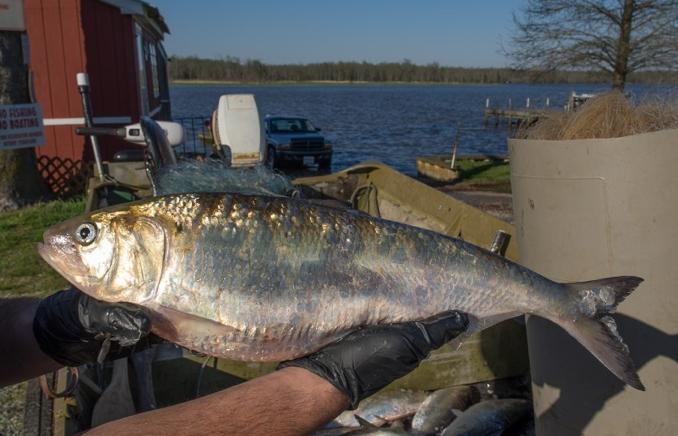American shad showed up in Virginia tributaries in their strongest numbers in years this spring, but their struggles on the Susquehanna River continued as biologists reported the lowest-ever shad count at the Conowingo Dam.
In between, biologists on the Potomac and Nanticoke rivers reported decent spawning runs, while hatchery operators generally reported average success in efforts to stock young shad into Bay tributaries.
This year’s spawning run was also delayed, biologists said, probably because of the long winter and protracted cool temperatures during the spring.
That may have contributed to the problems on the Susquehanna, where the first American shad did not reach the Conowingo Dam fish elevator until April 24 — weeks later than usual. Then, storms at the end of April resulted in higher-than-normal flows that appeared to hamper efforts to get fish upstream.
“The Susquehanna was definitely disappointing this year,” said Joshua Tryninewski, a fisheries biologist with the Pennsylvania Fish and Boat Commission. “That was definitely a combination of the late spring and high flows.”
Ultimately, just 10,425 American shad were lifted over the 100-foot-high dam, located 10 miles upstream from the Bay. That was the worst year since 1997, when a series of passages on lower Susquehanna River dams began trying to get migrating shad up the river.
The Susquehanna basin was historically the largest shad spawning grounds on the East Coast until a series of hydroelectric dams closed the river to migrating fish a century ago. Tens of millions of dollars have been invested in fish passages over the last quarter century, but their success has been limited. This year, just eight American shad made it past all four dams.
The news was better in other places, particularly at the other end of the Bay, where an annual survey by the Virginia Institute of Marine Science found solid shad numbers on the James, York and Rappahannock rivers.
“It was pretty impressive,” said Eric Hilton, the VIMS biologist who oversees the survey
The greatest increase was on the York, where the VIMS shad index had hovered near record lows for more than a decade. This year’s preliminary index — which factors together the weight and numbers of shad caught in survey nets — was about 10, more than double that of most recent years, and the best index since 2002.
The preliminary James index was about 7.4, up from about 4.5 last year, and the Rappahannock continued its steady increase of recent years with a preliminary index of 8.6 — the highest since the monitoring program began in 1998.
The Rappahannock River has performed well enough that state officials are planning to stop stocking hatchery fish in it next year.
“Certainly the Rappahannock has been the bright spot over the last six to seven years,” Hilton said.
On the adjacent Potomac River, biologists observed a “decent” shad run, said Jim Cummins, living resource director for the Interstate Commission on the Potomac River Basin. They caught 28 shad per net deployed, up from 20 last year though less than some years a decade ago.
Still, the Potomac shad population is considered the healthiest around the Bay, and the only one considered “sustainable” by the Atlantic States Marine Fisheries Commission, a state-federal body that regulates migratory fish catches along the coast.
“To me, sustainable is one thing, robust is another one,” Cummins cautioned. “It is not robust yet, but it is doing better in general.”
On the Eastern Shore, the Nanticoke River also had a solid spawning run, said Johnny Moore, a fisheries biologist with the Delaware Department of Natural Resources and Environmental Control’s Division of Fisheries.
“Even though the water temperatures were down and it was a little bit late, all in all, it was about a normal run,” Moore said.
Meanwhile, hatchery-based stocking efforts around the watershed placed about 15 million juvenile shad in Bay tributaries this spring and summer. That was similar to last year, though well below levels seen in the late 1990s, when Baywide totals routinely exceeded 20 million.
Shad and river herring are anadromous fish that spend most of their lives swimming along the coast but return to their native rivers to spawn. Once their numbers were staggering — stories from colonial times tell of migrations so dense that fish would be crushed by wagons crossing streams. For much of the 20th century, shad supported the most valuable commercial fishery in the Bay.
Decades of overfishing, dam construction, habitat destruction and pollution have reduced their numbers to a fraction of historic levels. Efforts around the Bay have sought to rebuild populations through stocking; the removal of dams and construction of other fish passages; and improved water quality, but populations have remained low.
By Karl Blankenship
Bay Journal News Service




Write a Letter to the Editor on this Article
We encourage readers to offer their point of view on this article by submitting the following form. Editing is sometimes necessary and is done at the discretion of the editorial staff.